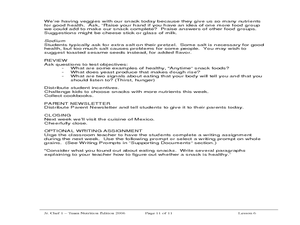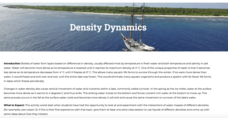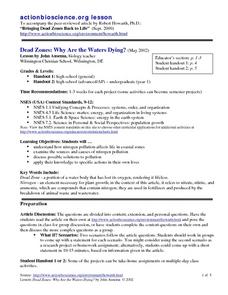Curated OER
Essential Nutrients - Daily Guides
List the recommended dietary guidelines and explain their function and implementation. (The guidelines are listed below) National Standards 14.3.1 Aim for fitness Aim for a healthy weight Be physically active each day
Curated OER
Non-nutrients: Fiber and Water
Students will identify the sources and function of carbohydrates and fiber and apply appropriate food preparation techniques.
Curated OER
Ocean Life Food Web
Students construct a food web representative of the Gulf of California. They use pictures to depict all of the organisms in the appropriate level of the web (producer, primary consumer, etc.)
Curated OER
Jr. Chef Club Super Snacks Lesson 6
Students explore healthy snacks. In this nutrition and cooking lesson, students observe and identify food groups on USDA's MyPyramid food guide. Students discuss how fiber helps our digestive system and follow a recipe using yeast to...
Curated OER
Nutrient Comic Strip
Students design a comic strip with a purpose of explaining what a specific nutrient does and how it functions in our body. They choose one of six nutrients and incorporate the research into a creative comic.
Curated OER
The Nutrients Public Transportation System
Students investigate the human circulatory system by experimenting with hoses. In this human body lesson, students create a system of hoses simulating the circulatory system which they utilize to pass objects through....
Curated OER
Anatomy of a Bone - Coloring
Clarify and color code the anatomy of a bone with this resource. This activity lists 7 parts of a bone along with a definition for each part. Learners read through this information and color in each part of the bone a listed color. They...
Curated OER
Density Dynamics
Students set up working models demonstrating lake turnover and the formation of deep water masses in the oceans.
Curated OER
3-Every-Day of Dairy: Nutrient Package
High schoolers discover the importance of calcium in their diets. In this nutrition lesson, students participate in an activity that requires them to conduct surveys regarding dairy and assessing what they eat. High schoolers discover...
Curated OER
Fun Faces of Wisconsin Agriculture: Curley's Beef Fast Facts
Students explore animal slaughter by researching the Wisconsin beef industry. In this meat statistics lesson, students practice using different math functions to identify how many burgers or sports equipment can be made from one...
NOAA
I Can't Breathe!
The Gulf of Mexico dead zone, an area of low oxygen that kills marine life, costs the United States $82 million every year. Young scientists research anoxic ocean environments then come up with a hypothesis for the cause of the Gulf of...
Curated OER
Dead Zones: Why Are the Waters Dying?
Students investigate the effects of pollution on marine ecosystems. They read and discuss an article, identify the effects of pollution on marine life, conduct research on local nutrient pollution, and conduct local water quality studies.
Curated OER
Bacteria Lab II: Effect of Bacteriocides
Written to follow "Bacteria Lab I: Preparing Agar Plates and Culturing Bacteria," also found via the Lesson Planet site, this lab sheet instructs your microbiologists to test a bacteriocide for effectiveness. In the preceding lab, they...
Curated OER
How Much is Dirt Worth?
Dirt is worthless, isn't it? Find out the true value of dirt, and by dirt I mean soil. The class explores what makes soil, the types of soil, and what happens when soil becomes void of its nutrients. There are several great activities,...
Curated OER
Raven Chapter 37 Guided Notes: Plant Transport
Introduce botany or biology beginners to nutrient transport in plants by assigning this worksheet. Learners describe turgor pressure and its role in hydroregulation. They explain the functions of xylem, phloem, stomata, and guard cells....
Curated OER
AP: Chapter 36: Transport in Plants
When you need a review worksheet for your AP biologists on water and nutrient transport in plants, this one is for you! From the simple stuctures involved to the complex mechanisms that make it happen, the details of transport are...
Curated OER
Fungi
Lovely pictures help to summarize the different characteristics of fungi in this PowerPoint which covers structure, function and the way that fungi get nutrients. Symbiotic relationships are examined, and some commercial uses are...
Curated OER
A Planting We Will Go
Even the youngest kids can make scientific comparisons using collected data. They read The Tiny Seed, then discuss the essential nutrients and elements needed for a seed to grow into a blooming plant. They plant seeds and track their...
Primary Resources
Eating a Balanced Diet
A perky presentation provides an overview of what comprises a balanced diet. Viewers discover why water is vital to our health, what the macro-nutrients are and what they provide, and how calcium is important to bones and teeth. The...
New South Wales Department of Education
Photosynthesis
Venus fly traps photosynthesize and consume insects because the soil they live in does not provide enough nutrients. Scholars analyze historical scientific experiments to learn how scientists discovered photosynthesis. From their...
Laboratory for Atmospheric and Space Physics
Marvelous Martian Mineralogy
Believe it or not ... martian soil does have nutrients needed for plants to survive! An out-of-this-world tutorial moves scholars through an analysis of martian soil to determine its chemical make-up. Pupils analyze reflectivity of...
Baylor College
Needs of Plants
What better way to learn about plant life than by creating a class garden? Young botanists start with a brief discussion about radishes before planting seeds and watching them grow. To determine the importance of water,...
Science Matters
Celery Lab
See firsthand the work plants do to move nutrients through their systems with a instructional activity that demonstrates the role of the xylem and phloem in plants. Young scientists observe celery move colored water through its stem to...
CCEA
Home Economics: Teen Building
Learners explore the emotional and nutritional needs of teenagers in a six-lesson unit, which covers such topics as food sources, cooking skills, emotional well-being, and the positive effect of food and family occasions.
Other popular searches
- Six Essential Nutrients
- Plant Growth Nutrients
- 6 Basic Nutrients
- Essential Nutrients
- Nutrients in Food
- Digestion of Nutrients
- Six Nutrients
- Plant Nutrients
- Food Nutrients
- Excess Nutrients
- Nutrients Fat
- 6 Essential Nutrients























